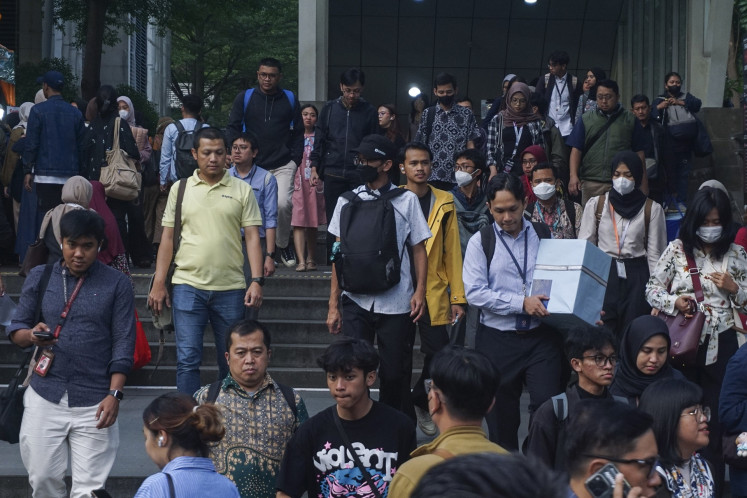Popular Reads
Top Results
Can't find what you're looking for?
View all search resultsPopular Reads
Top Results
Can't find what you're looking for?
View all search resultsRaja Ampat strives to be marine tourist spot
The administration of Raja Ampat, a group of small islands in Papua that was established as a regency in 2003, says it is committed to speeding up development with the eventual goal of turning the forest dominated area into a tourist destination
Change text size
Gift Premium Articles
to Anyone
T
he administration of Raja Ampat, a group of small islands in Papua that was established as a regency
in 2003, says it is committed to speeding up development with the eventual goal of turning the forest dominated area into a tourist destination.
In 2003, Wasai, the capital of the regency, was home to an elementary school, a community health center, 20 houses and had a total electricity supply of a paltry 20-kilowatts.
“We started [developing this regency] from zero. We found inadequacies everywhere,” Raja Ampat regent Marcus Wanma recalled of his first days in office. “When we first came to Waisai, we had to build tents in which to live and for our office.”
Five years into a program to rapidly develop the island that focuses on infrastructure and public services, the regency is well on its way to achieving self reliance.
Since 2003, the administration has built thoroughfares, piers, bridges and traditional markets in the regency. Office buildings, business centers, schools, hospitals and hotels are now widespread.
Keen to take advantage of the province’s impressive marine biodiversity and underwater landscapes, the regency is intent on promoting itself as a tourist destination.
The maritime regency consists of 610 islands with a combined coastline more than 753 kilometers in length. The area is home to the richest wildlife diversity in the archipelago and the Pacific Ocean.
Raja Ampat boasts tourist draws
including a lush coastal ecosystem and unique cultures.
Dense coral reefs, mangrove forests, sea grass and exotic beaches are some of the draws.
Raja Ampat is situated in the coral triangle between the Philippines, Papua New Guinea and Australia. It is the center of the richest natural tropical marine diversity in the world.
With more than 500 coral species in its waters — more than half of the world’s coral species — as well as 828 coral fish species — the area also has the potential to host natural conservation centers.
A joint team comprising Conservation International, Nature Conservancy and the National Oceanography Agency, conducted a research in 2002 in the island group and found 540 species of hard coral (75 percent of the global species) and more than 1,000 species of
coral fish.
There is also a diverse selection of flora and many endemic animal species, including the spotted couscous and the yellow-crested cockatoo.
Located on the northwest tip of West Papua province, Raja Ampat consists of 610 islands, including four main islands — Waigeo, Batanta, Misool and Salawati.
The regency spans is 881,953 square kilometers with a total land area of 46,000 square kilometers, and comprises 17 districts and 97 villages.
Marcus said building a tourism industry was not just a matter of attracting tourists but providing opportunity for local people to improve their livelihoods.
“That’s why we are developing a community-based tourism industry. Local people should be able to capitalize on this sector,” Marcus said.
The administration provides training for local people to develop skills such as creating handicrafts and learning traditional dances and rituals. Targeting the global market, the local administration has been promoting the regency as a “marine paradise” in a number of exhibitions in many countries.
It also recently opened a promotional office in Bali.
Thanks to the regency’s efforts, Raja Ampat is now well-known among diving enthusiasts.
The regency attracted around 4,000 tourists last year, most of them foreign tourists from the US, Australia, Japan and European countries. The regency is targeting to increase tourist arrivals from 5,000 to 6,000 this year.
To improve accessibility to the area, the regency has built roads, telecommunication networks and is constructing two new airports in Waigeo, Misool, Waisai and Ayau.
The airports have been under construction since 2007 and have cost the administration around Rp 2.5 billion each. Currently, Sorong is the only departure hub serving flights to Raja Ampat.
“Tourists can only go to Raja Ampat via Sorong, and then must continue their trip via ferry. We expect the new airports to be operational by the end of this year,” Marcus said.
Direct flights to Sorong are available from Manado and Makassar and connecting flights from Jakarta and Bali.
With support from the central government and investors, Marcus said, the administration was confident Raja Ampat would become a world-class marine tourist destination by 2015.










